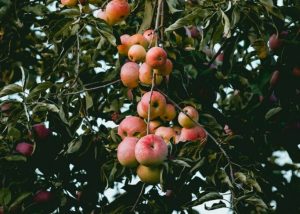Anyone can successfully prune their own fruit trees if they follow a few simple rules. First, remember that annual pruning can enhance fruit production and control the size of the tree.
Learn the difference between fruiting wood and vegetative growth. It’s possible to prune out too much of the fruiting wood or spurs, resulting in few blossoms and little fruit. There’s a great chart at https://anrcatalog.ucanr.edu/pdf/8057.pdf that tells where fruiting buds are located on various kinds of fruit trees.
When you prune, use a ladder. To avoid damage or broken branches, do not climb the tree or pull branches toward you. Try not to remove more than twenty-five percent of the tree canopy in a single year. Severe pruning can shift the tree from fruit production to growth.
Walk around your tree and look for weak, dead, diseased or crossing branches. Also, look for the growth of “suckers” from the base of the tree. Remove all of these branches and sprouts first, using a sharp pair of pruning shears, a lopper, or a small saw, depending on the size of the wood.
Remember no two people prune a tree in the same way. Chuck Ingels, University of California Farm Advisor, says, “There are many ways to train and prune deciduous fruit trees, and no single method is right for all situations and needs.” Do not be afraid to make mistakes.
Think of how you want your tree to look. In most cases, you want a scaffold of 3 to 4 branches in the shape of a vase or wine glass with upward pointing branches and an open center for good air circulation.
When deciding where and what branch to cut, remember that cutting encourages growth from the bud just below the cut. Choose a bud that faces the direction you want to direct new growth. Cut cleanly at roughly a forty-five-degree angle one-quarter of an inch above the selected bud. Do not leave a large stub. If you are removing a branch to the trunk of the tree look for the rounded collar at the base of the branch and cut at its outside edge, so as to not leave a stub.
Remove vigorous upright shoots (“water sprouts”) and most competing branches growing straight up into the tree. Upright branches are generally vegetative (stems and green leaves); horizontal branches are more fruitful.
Be sure to remove all leaves and old fruit or failed blossoms. Rake the area thoroughly of all litter and branches to be sure no insect eggs or diseased materials are left around the tree.
To protect your tree from sunburn and borers (especially in winter) paint the trunk of the tree with a fifty-fifty mix of interior white latex paint and water. For more information: https://anrcatalog.ucanr.edu/Items.aspx?search=Fruit%20Tree%20Pruning
Jack Bennett has been a University of California Cooperative Extension Master Gardener in Tuolumne County since 2006.


